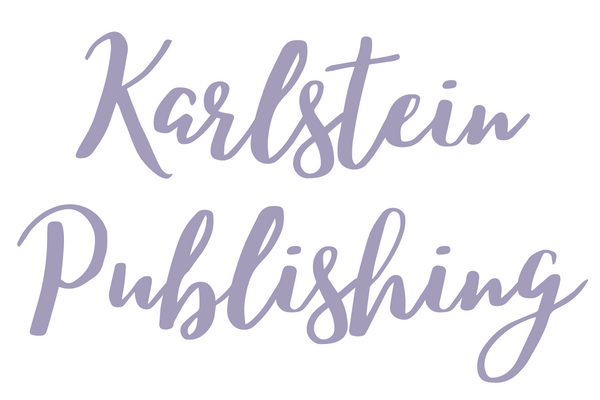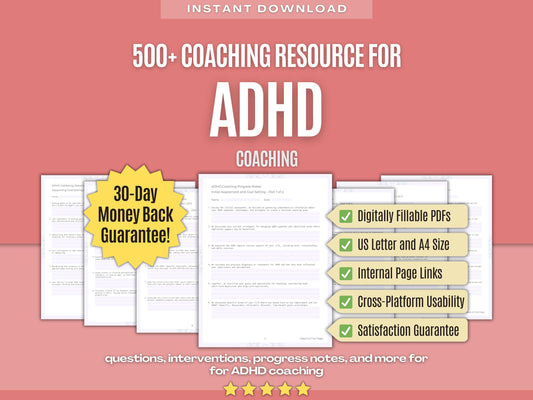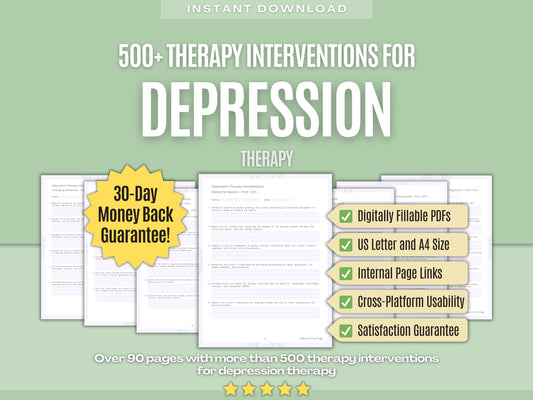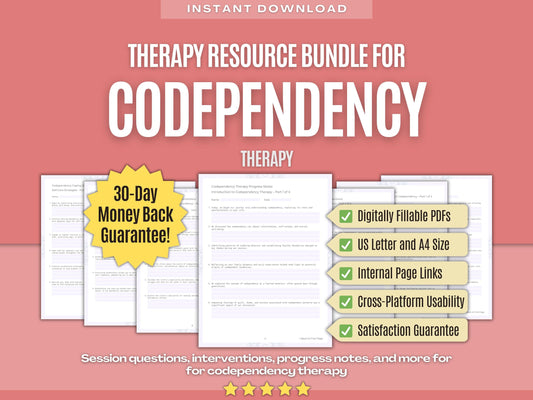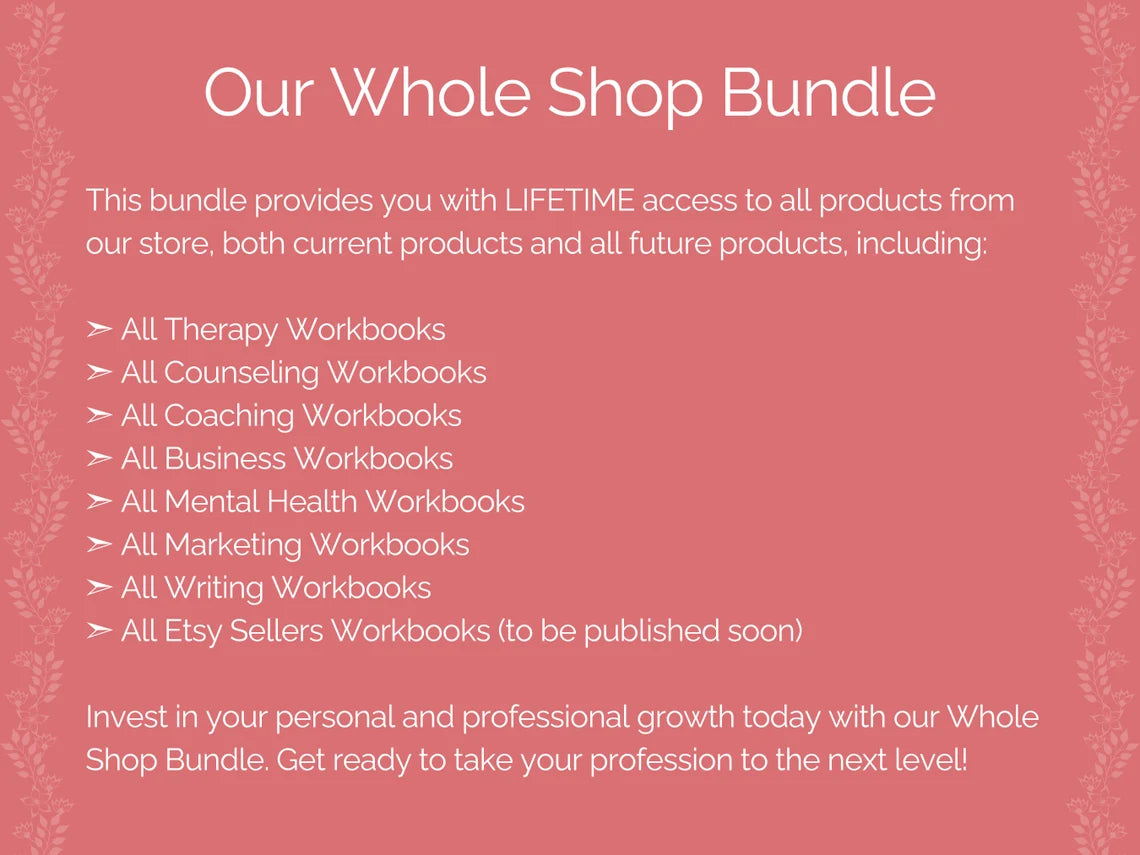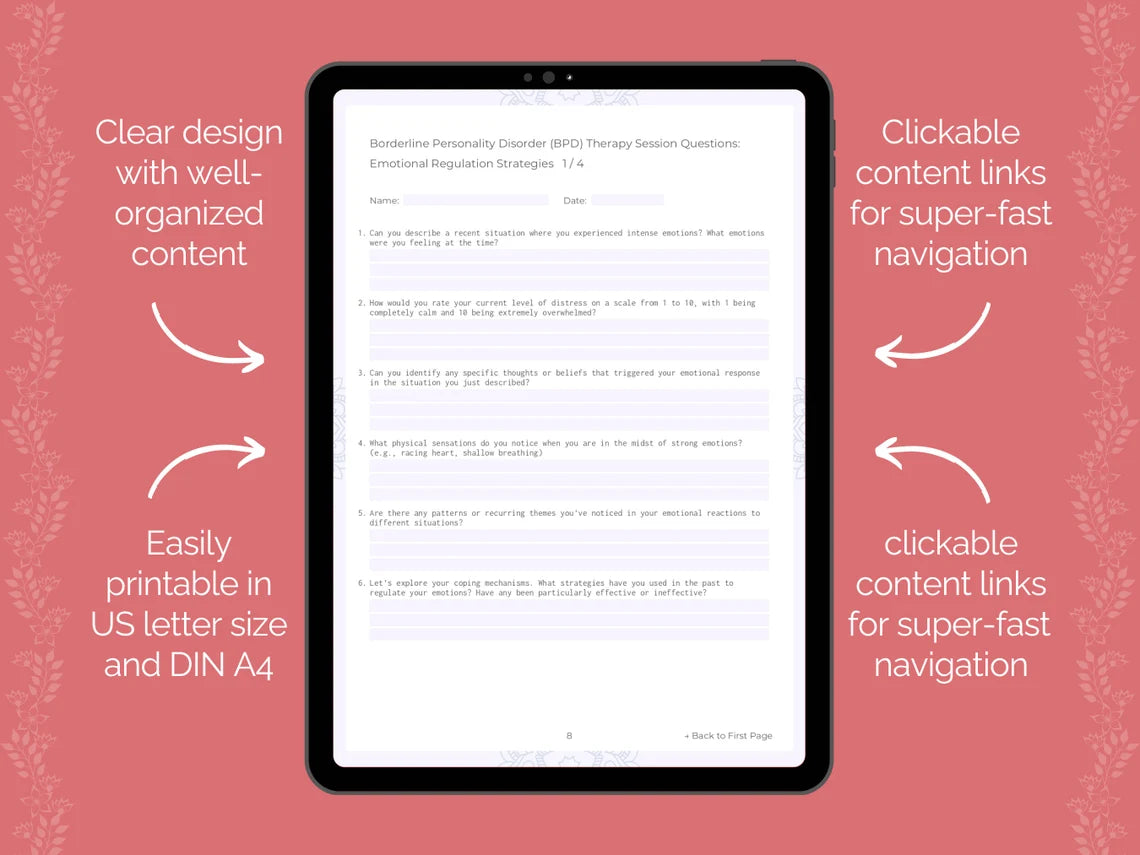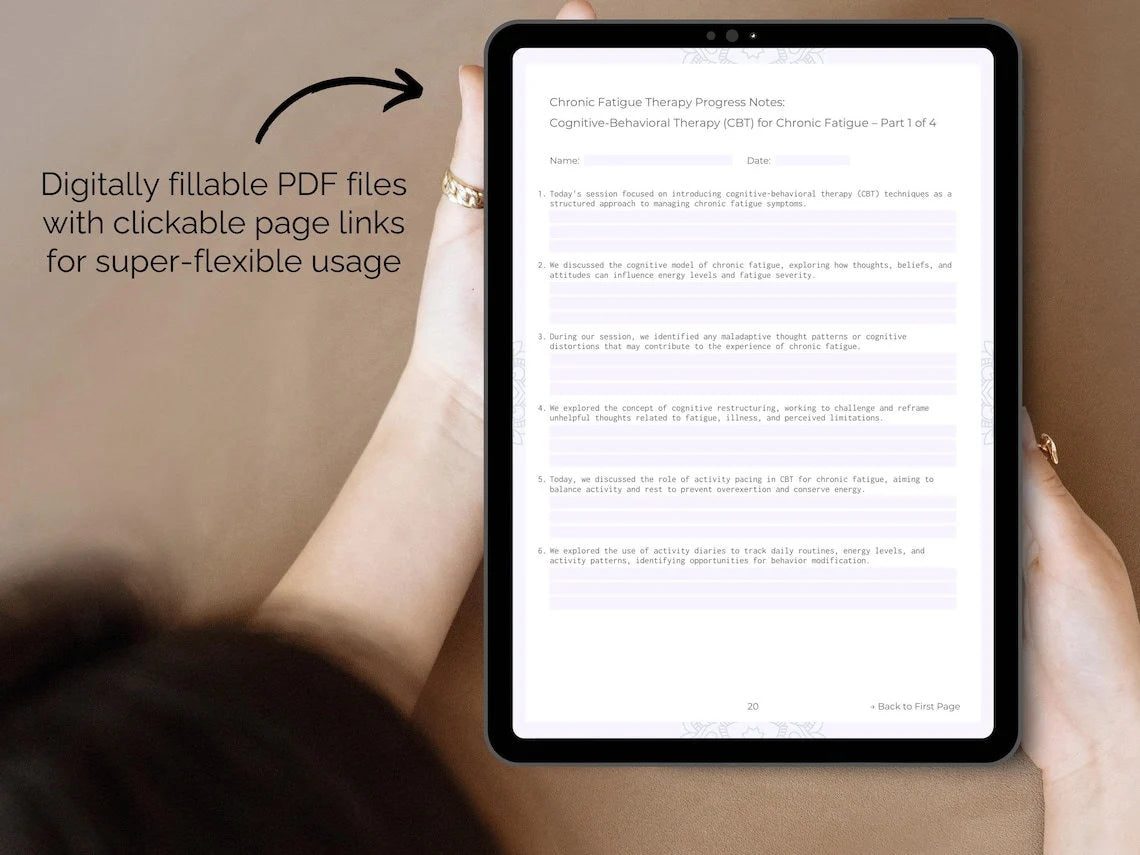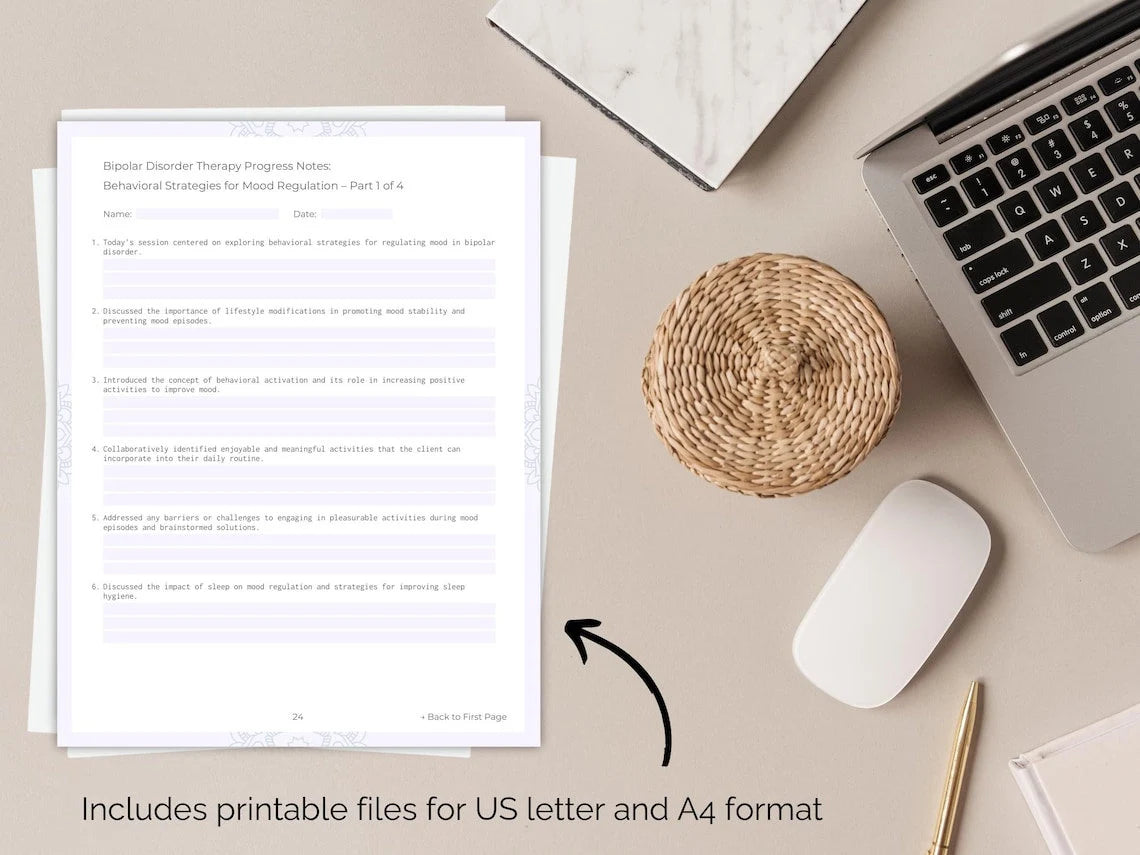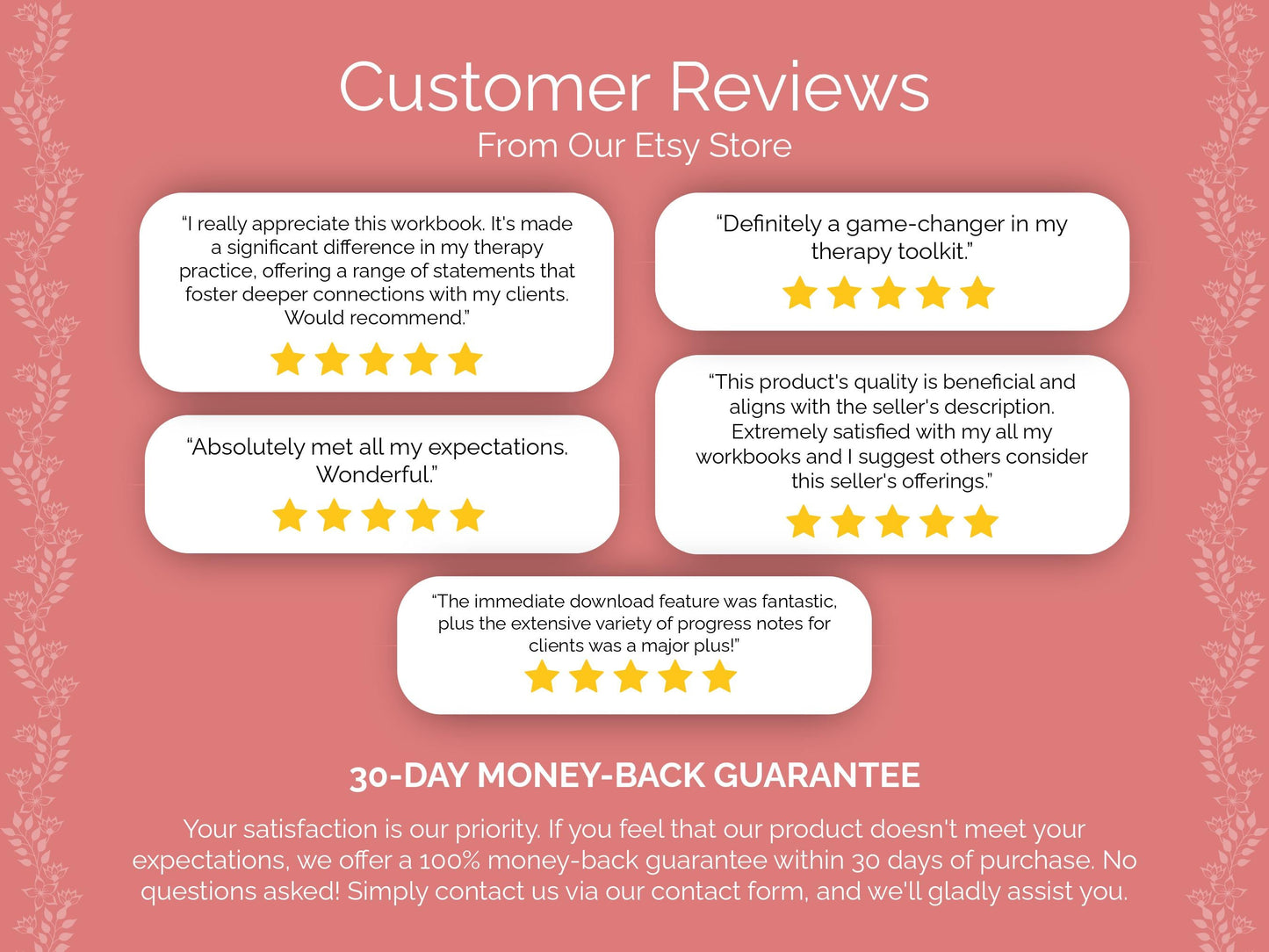Elevate Your Therapy and Guide Your Clients to Inner Healing with Our Burnout and Prevention Coping Skills! ✨
1. Identifying Signs and Symptoms of Burnout
- Pay attention to physical cues such as headaches, fatigue, or changes in appetite, as these can signal the onset of burnout.
- Keep track of changes in behavior patterns, such as withdrawing from social interactions, neglecting self-care, or relying on unhealthy coping mechanisms like excessive alcohol consumption or overeating.
- Take note of any changes in productivity or performance, such as decreased motivation, difficulty concentrating, or making more errors than usual.
- Consider how you feel about your work-life balance, noticing if you are consistently working long hours, bringing work home, or feeling unable to disconnect from job-related responsibilities.
- Notice any changes in sleep patterns, including difficulty falling asleep, waking up frequently during the night, or feeling unrefreshed after a full night's rest.
- Consider how you spend your leisure time and hobbies, noting if you still find enjoyment and relaxation in these activities or if they have become neglected due to work-related demands.
- Notice if you find yourself frequently dwelling on work-related problems or feeling overwhelmed by the volume of tasks and responsibilities on your plate.
- Pay attention to any changes in your communication style, such as becoming more abrupt or withdrawn in interactions with colleagues, clients, or loved ones.
- Reflect on your overall sense of energy and vitality, noting if you feel consistently drained and depleted or if you have periods of sustained energy and enthusiasm.
- Notice if you experience feelings of guilt or shame related to taking breaks, delegating tasks, or setting boundaries at work, as these can be signs of underlying burnout.
- Pay attention to changes in your social interactions and relationships, noting if you withdraw from social activities or if you have difficulty connecting with others due to feelings of exhaustion or disinterest.
Need more? Find all 500+ Coping Skills for Burnout and Prevention Therapy in our Digital Workbook!
2. Assessing Your Stress Levels
- Begin by identifying specific stressors in your life, such as work deadlines, financial concerns, or relationship conflicts, to gain clarity on what is contributing to your stress levels.
- Consider your emotional responses to stress, such as feelings of anxiety, irritability, or sadness, to better understand how stress is affecting your mental well-being.
- Reflect on your behavioral responses to stress, such as procrastination, avoidance, or increased use of substances like alcohol or tobacco, to recognize maladaptive coping mechanisms.
- Evaluate your overall sense of energy and vitality, noting if you feel consistently drained and fatigued or if you have periods of sustained energy and enthusiasm.
- Consider the impact of stress on your relationships with others, noting if you experience conflicts or tension with friends, family members, or colleagues as a result of heightened stress levels.
- Reflect on your use of coping strategies to manage stress, noting if you rely primarily on unhealthy coping mechanisms like avoidance or substance use, or if you have effective strategies in place to promote resilience and well-being.
- Evaluate your ability to set boundaries and prioritize self-care, noting if you struggle to say no to additional responsibilities or if you neglect your own needs in favor of meeting the demands of others.
- Consider the impact of stress on your physical health and well-being, noting if you experience exacerbation of pre-existing health conditions or if you have developed new symptoms as a result of stress.
- Reflect on your level of satisfaction with various areas of your life, including work, relationships, hobbies, and personal goals, noting if you feel fulfilled and content or if you experience a sense of dissatisfaction and longing for change.
- Evaluate your level of self-awareness and insight into your own stress triggers and responses, noting if you are able to recognize when you are feeling stressed and take proactive steps to manage your stress levels.
- Reflect on your level of motivation and enthusiasm for work and other activities, noting if you feel inspired and driven to pursue your goals or if you experience a lack of interest and motivation due to stress-related burnout.
Need more? Find all 500+ Coping Skills for Burnout and Prevention Therapy in our Digital Workbook!
3. Setting Healthy Boundaries
- Start by identifying your own needs, values, and priorities to establish a clear understanding of what is important to you in various aspects of your life.
- Communicate assertively with others, expressing your needs, preferences, and limits in a clear and respectful manner, while also being open to hearing and considering their perspectives.
- Set limits on the amount of time and energy you devote to work, relationships, and other commitments to prevent burnout and maintain a healthy balance in your life.
- Prioritize self-care and make time for activities that replenish your energy and nourish your spirit, even if it means saying no to other demands on your time.
- Practice self-compassion and avoid self-blame when setting boundaries, recognizing that it is a necessary act of self-care and not a selfish or unreasonable behavior.
- Practice mindfulness and self-awareness to tune into your own emotions, physical sensations, and internal cues, which can help you identify when your boundaries are being tested or crossed.
- Learn to differentiate between healthy boundaries, which promote self-care and well-being, and rigid or porous boundaries, which can lead to feelings of isolation or overwhelm.
- Take small steps towards setting boundaries, starting with situations where you feel relatively comfortable asserting yourself, and gradually challenging yourself to set boundaries in more challenging circumstances.
- Set boundaries around technology use and screen time to prevent digital overload and create space for meaningful connections and activities offline.
- Seek feedback from trusted friends, family members, or colleagues about your boundary-setting efforts, and be open to receiving constructive criticism and suggestions for improvement.
- Recognize that setting boundaries is an ongoing process that requires practice, patience, and self-reflection, and be gentle with yourself as you navigate this journey.
Need more? Find all 500+ Coping Skills for Burnout and Prevention Therapy in our Digital Workbook!
4. Developing Resilience
- Cultivate a growth mindset by reframing setbacks and challenges as opportunities for learning and growth, recognizing that resilience is built through adversity.
- Develop a strong support network of friends, family members, and peers who can provide encouragement, validation, and perspective during times of difficulty.
- Practice optimism and positive thinking by focusing on solutions and possibilities rather than dwelling on problems and limitations.
- Develop healthy coping mechanisms for managing stress and adversity, such as relaxation techniques, exercise, and creative outlets for self-expression.
- Practice flexibility and adaptability in responding to changing circumstances, recognizing that rigidity and resistance can undermine resilience.
- Seek out opportunities for personal growth and development, whether through formal education, training programs, or self-directed learning initiatives.
- Develop effective problem-solving skills by breaking down complex problems into manageable steps and seeking out support and guidance when needed.
- Build resilience through physical health and well-being by prioritizing regular exercise, nutritious eating, adequate sleep, and relaxation.
- Practice self-care and prioritize your own well-being, recognizing that caring for yourself is essential for sustaining resilience and preventing burnout.
- Foster a sense of community and connection by volunteering, participating in group activities, or joining support groups, providing opportunities for social support and resilience-building.
- Draw on past experiences of resilience and overcoming adversity as a source of inspiration and confidence in your ability to navigate current challenges.
Need more? Find all 500+ Coping Skills for Burnout and Prevention Therapy in our Digital Workbook!
5. Enhancing Work-Life Balance
- Establish clear boundaries between work and personal life by setting specific times for work-related tasks and leisure activities, and stick to them as much as possible.
- Delegate tasks to colleagues or family members when possible, recognizing that you don't have to handle everything on your own and that sharing responsibilities can lighten your workload.
- Schedule regular breaks throughout your workday to rest and recharge, whether it's a short walk outside, a few minutes of deep breathing, or a brief meditation session.
- Communicate openly with your employer or colleagues about your need for work-life balance, advocating for flexible scheduling options or adjustments to your workload if necessary.
- Engage in activities outside of work that bring you joy and fulfillment, whether it's hobbies, exercise, spending time with loved ones, or pursuing personal interests.
- Create a daily or weekly routine that includes both work and self-care activities, ensuring that you allocate sufficient time for relaxation, exercise, and socialization outside of work commitments.
- Set realistic goals for both work and personal life, acknowledging your limitations and focusing on achievable outcomes rather than striving for perfection.
- Seek out resources and support services offered by your employer, such as employee assistance programs or wellness initiatives, to help you manage stress and promote work-life balance.
- Take regular vacations or breaks from work to recharge and rejuvenate, allowing yourself time to disconnect from work responsibilities and fully enjoy leisure activities.
- Foster open communication with your family or household members about your work commitments and the importance of maintaining balance, collaborating on strategies to support each other's needs.
- Seek professional support from therapists, counselors, or coaches if you're struggling to maintain work-life balance despite your best efforts, recognizing that it's okay to ask for help when needed.
Need more? Find all 500+ Coping Skills for Burnout and Prevention Therapy in our Digital Workbook!
6. Exploring the Role of Physical Activity
- Engage in regular aerobic exercise, such as brisk walking, jogging, or cycling, to boost your cardiovascular health and improve your mood through the release of endorphins.
- Try out different types of physical activities, such as dancing, swimming, or playing sports, to find enjoyable ways to stay active and motivated.
- Find a workout buddy or exercise group to provide accountability and social support, making physical activity a fun and social experience rather than a chore.
- Practice mindful movement by paying attention to your body's sensations and movements during exercise, focusing on the present moment and tuning into the connection between your mind and body.
- Experiment with interval training workouts, alternating between periods of high-intensity exercise and recovery periods, to maximize calorie burn and cardiovascular benefits in less time.
- Make physical activity a priority by scheduling it into your daily or weekly routine, treating it as an essential part of your self-care regimen rather than something to be squeezed in when convenient.
- Listen to your body and adjust your workout intensity and duration based on how you're feeling, giving yourself permission to rest and recover when needed to prevent burnout or injury.
- Join a fitness class or group exercise program to add variety to your workouts and benefit from the motivation and camaraderie of exercising with others.
- Use physical activity as a way to disconnect from technology and screen time, allowing yourself to fully immerse in the present moment and enjoy the sensory experience of movement.
- Make exercise a family affair by involving your loved ones in active pursuits such as family walks, bike rides, or backyard games, fostering bonds and creating lasting memories together.
- Use physical activity as a way to express creativity and self-expression, whether it's through dance, martial arts, or outdoor adventure sports that challenge and inspire you.
Need more? Find all 500+ Coping Skills for Burnout and Prevention Therapy in our Digital Workbook!
7. Engaging in Hobbies and Interests
- Explore activities or hobbies that once brought you joy or interest but have been neglected due to burnout. Reconnecting with these interests can reignite your passion and provide a much-needed break from stress.
- Consider activities that allow you to fully immerse yourself in the present moment, such as painting, gardening, or cooking. These activities can serve as a form of mindfulness, helping to alleviate stress and promote relaxation.
- Join a club or group related to one of your interests, such as a book club, hiking group, or art class. Connecting with others who share your passions can provide a sense of community and support.
- Keep a journal or scrapbook documenting your experiences and progress in your hobbies. Reflecting on your accomplishments can boost self-esteem and motivation.
- Practice self-compassion and avoid judging yourself for not being "productive" during hobby time. Remember that rest and relaxation are essential for overall well-being.
- Explore different types of hobbies to find what resonates with you. This could include activities such as knitting, photography, birdwatching, or woodworking.
- Set achievable goals related to your hobbies, whether it's mastering a new skill, completing a project, or participating in an event or competition.
- Practice mindfulness while engaging in hobbies, paying attention to sensory experiences such as the texture of clay or the smell of flowers in a garden.
- Create a dedicated space in your home for pursuing hobbies, whether it's a craft corner, music studio, or gardening area.
- Use hobbies as a form of distraction when feeling overwhelmed or stressed, allowing yourself to temporarily escape into a world of creativity and enjoyment.
- Take breaks from screens and technology during hobby time to fully immerse yourself in the experience and reduce mental clutter.
Need more? Find all 500+ Coping Skills for Burnout and Prevention Therapy in our Digital Workbook!
8. Understanding the Power of Gratitude
- Begin by cultivating awareness of the present moment, noticing the small blessings and positive aspects of your life that you may have overlooked.
- Express gratitude verbally or in writing to those who have had a positive impact on your life. Whether it's a friend, family member, colleague, or mentor, sharing your appreciation can deepen your relationships and foster connection.
- Reflect on past experiences and identify lessons learned or silver linings that emerged from difficult situations. Recognizing the growth and resilience that can come from adversity can foster a sense of gratitude.
- Create a gratitude jar or box, where you can write down moments of gratitude on slips of paper and revisit them during times of stress or sadness.
- Engage in acts of kindness and service to others, recognizing the ripple effect of gratitude that occurs when we give back to our communities.
- Practice self-compassion and gratitude for yourself, acknowledging your own strengths, resilience, and achievements.
- Use gratitude as a form of self-care, incorporating practices such as gratitude walks, baths, or rituals into your routine.
- Practice gratitude rituals or traditions with loved ones, such as sharing gratitude at mealtimes or before bed.
- Challenge yourself to find gratitude in unexpected places or situations, expanding your capacity for appreciation beyond the obvious.
- Cultivate an attitude of abundance rather than scarcity, recognizing the abundance of blessings and opportunities in your life.
- Practice gratitude as a form of spiritual or religious practice, connecting with a higher power or source of meaning and purpose.
Need more? Find all 500+ Coping Skills for Burnout and Prevention Therapy in our Digital Workbook!
9. Planning for Recovery and Maintenance
- Begin by assessing your current level of burnout and identifying areas of your life that may need attention in order to promote recovery and prevent future burnout.
- Develop a personalized self-care plan that includes activities and practices that promote physical, emotional, and mental well-being.
- Practice mindfulness techniques to stay grounded and present in the moment, especially during times of stress or overwhelm.
- Seek out professional help if needed, whether it's from a therapist, counselor, or other mental health professional who can offer support and guidance.
- Practice assertive communication skills to express your needs, preferences, and boundaries effectively, especially in the workplace.
- Incorporate relaxation techniques into your daily routine, such as deep breathing exercises, progressive muscle relaxation, or guided imagery.
- Develop healthy coping mechanisms for managing stress, such as exercise, journaling, or spending time in nature.
- Practice self-compassion and kindness toward yourself, especially during times of struggle or setback.
- Engage in activities that promote physical health, such as exercise, healthy eating, and regular medical check-ups.
- Develop a sense of purpose and meaning in your life by connecting with your values, passions, and goals.
- Cultivate resilience by learning from setbacks and challenges, viewing them as opportunities for growth and learning.
Need more? Find all 500+ Coping Skills for Burnout and Prevention Therapy in our Digital Workbook!
10. Celebrating Achievements and Recognizing Progress
- Begin by acknowledging your accomplishments, no matter how small, and recognizing the effort and dedication it took to achieve them.
- Set aside time to celebrate your achievements, whether it's with a small treat, a moment of relaxation, or sharing your success with loved ones.
- Share your successes with others, whether it's with friends, family members, or colleagues, who can offer support and encouragement.
- Recognize the challenges and obstacles you have overcome along the way, acknowledging your resilience and perseverance.
- Set new goals and aspirations for yourself, building on your past achievements and pushing yourself to reach new heights.
- Take time to savor the moment and bask in the feeling of success, allowing yourself to fully experience and appreciate your accomplishments.
- Treat yourself to a reward or indulgence as a way of celebrating your hard work and dedication.
- Surround yourself with reminders of your accomplishments, whether it's awards, certificates, or personal mementos that symbolize your success.
- Celebrate the progress you've made, even if you haven't reached your ultimate goal yet, recognizing that every step forward is a victory worth celebrating.
- Take time to reflect on the qualities and strengths that have contributed to your success, recognizing your unique talents and abilities.
- Practice mindfulness and presence as you celebrate your achievements, allowing yourself to fully experience and savor the moment.
We hope that our coping skills for Burnout and Prevention therapy will help you to elevate your therapy practice and guide your clients to inner healing! Do you need more coping skills for Burnout and Prevention therapy? Find them all in our Digital Workbook! Or do you have any questions or suggestions for us? Please feel free to contact us at any time!
